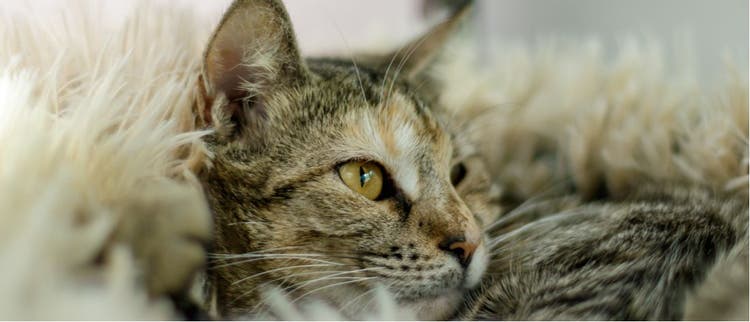
Choosing a Domestic Shorthair
While the domestic shorthair is not considered a breed as such by the cat associations, it always will be best of breed in American homes and hearts. And since an estimated 95 percent of all domestic cats in North America are random-bred, our “ordinary” everyday short-coated house cats win the popularity contest paws down. There’s nothing ordinary about them. Random-bred or mixed breed short-haired cats, with their healthy mix of genes and diverse personalities, colors, patterns, and body styles, make champion companions. The smallest domestic shorthair deserves just as much love, quality care, and respect as the finest grand champion purebred.
History and Origin of Domestic Short-haired Cats
Short-haired domestics have been with us from the earliest days of domestication. It’s thought that our modern day domestics are descendants of the short-haired African wildcat, Felis silvestris lybica. Put them side to side, and you might have a difficult time distinguishing the African wildcat from your average short-haired tabby-striped couch cougar. These wildcats interbred easily with domestic cats, so easily, in fact, that conservationists fear the African wildcat will become extinct as a pure species.
Around 10,000 years ago, when humans evolved from hunter-gatherers to members of settled communities who grew and stored food, cats learned that humans provided a reliable food source — the rodents attracted to the stored food supplies. At first, these short-haired, shy felines lived at the edges of settled communities. Humans soon discovered that these cats were useful in ridding the granaries and fields of ravaging rodents, and a symbiotic relationship developed. Although cats were first welcomed for their rodent and snake-killing abilities, around 4,000 years ago in Egypt cats became beloved household companions as well. Later, during the time of the Egyptian cat cult, cats were considered sacred physical manifestations of the goddess Bast.
The Egyptians were fiercely protective of their sacred felines, but eventually Phoenician traders transported cats to Europe and the British Isles. Romans smuggled cats out of Egypt and brought them along into conquered regions such as France, Germany, Holland and Spain. Buddhist Monks transported cats to the Orient.
With the advent of sailing ships, cats were transported to new areas, including the New World. They appear in American paintings and needlework samplers of the 1600s and 1700s, indicating that cats arrived with the pilgrims or shortly after. These hardy short-haired feline immigrants established themselves in America and today the domestic shorthair enjoys a worldwide popularity.
Appearance of a Domestic Shorthair
The variety of the domestic shorthair knows no bounds. Big or small, white or black, calico patched or tabby striped, the short-haired American domestic is diverse and outnumbers the domestic longhair approximately 10 to one. Coat type, pattern, and color vary from place to place, and certain areas often have a greater number of, say, tabbies, calicos, or solids, or the ever popular tuxedo cat, with her black and white formal wear. Nothing is remarkable about this. Cats choose mates from their immediate vicinity. If that area has many cats with tabby coats, those cats will pass along their dominant tabby genes to their offspring.
Body type also varies depending upon area as well. Cats from colder climates tend to have stockier bodies and denser coats, while cats from warmer regions have slimmer bodies and thinner coats.
Sometimes, a domestic shorthair looks like a particular pedigreed breed. For example, a domestic shorthair can possess the color-point pattern of the Siamese, or may possess the short, solid blue coat of the Russian blue. However, usually these cats merely resemble their pedigreed cousins, and are random-bred domestics rather than purebreds that somehow found their way into the domestic cat population.
Domestic Short-haired Cat’s Personality
As varied as their multicolored exteriors, domestic shorthairs come in all types of temperaments. Since the ancestry of the domestic kitten is generally not known and (as a rule) they don’t breed true as most purebreds do, it’s difficult to predict what the cat will be like as an adult. It may be quiet or vocal, large or small, outgoing or withdrawn. While purebreds do have their own unique personalities, they are more likely to follow the pattern of their breed and therefore produce predictable offspring.
With the random-bred domestic shorthair, anything is possible. Generally, however, shorthairs are a bit more lively than their long-haired counterparts. If you were able to see the parents — which is often difficult – their temperaments would give you an idea of what the kitten would be like as an adult. Remember, however, that a cat’s temperament depends greatly on his early socialization and care. You need to spend time with your cat if you are to develop a close, loving relationship.
Grooming a Domestic Shorthair
This depends on the length, texture, and fullness of the coat, but generally domestic shorthairs need minimal grooming. Cats with short fur that lays flat on the body and possesses little downy undercoat need virtually none. If your cat has short fur that is dense and stands away from her body, she has a downy undercoat and will need to be groomed once or twice a week.
However, all cats can benefit from regular grooming. Grooming removes dead hair that can form hair balls in a cat’s stomach (plus form a furry layer on your couch), gets rid of dead skin and dander, stimulates the skin, tones muscles, and encourages blood circulation. It is also a good opportunity to examine your cat for developing health problems and attend to them in their early stages when they are easier to treat.
For more information on the Domestic Short-haired breed, please see the article Selecting and Showing Your Domestic Shorthair.